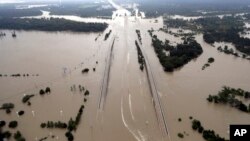Two weeks before Harvey's floodwaters engulfed much of Houston, President Donald Trump quietly rolled back an order by his predecessor that would have made it easier for storm-ravaged communities to use federal emergency aid to rebuild bridges, roads and other structures so they can better withstand future disasters.
Now, with much of the nation's fourth-largest city under water, Trump's move has new resonance. Critics note the president's order could force Houston and other cities to rebuild hospitals and highways in the same way and in the same flood-prone areas.
"Rebuilding while ignoring future flood events is like treating someone for lung cancer and then giving him a carton of cigarettes on the way out the door," said Michael Gerrard, a professor of environmental and climate change law at Columbia University. "If you're going to rebuild after a bad event, you don't want to expose yourself to the same thing all over again."
Trump's action is one of several ways the president, who has called climate change a hoax, has tried to wipe away former President Barack Obama's efforts to make the United States more resilient to threats posed by the changing climate.
Consideration of climate predictions
The order Trump revoked would have permitted the rebuilding to take into account climate scientists' predictions of stronger storms and more frequent flooding.
Bridges and highways, for example, could be rebuilt higher, or with better drainage. The foundation of a new fire station or hospital might be elevated an extra 3 feet (1 meter).
While scientists caution against blaming specific weather events like Harvey on climate change, warmer air and warmer water linked to global warming have long been projected to make such storms wetter and more intense. Houston, for example, has experienced three floods in three years that statistically were once considered 1-in-500-year events.
The government was still in the process of implementing Obama's 2015 order when it was rescinded. That means the old standard — rebuilding storm-ravaged facilities in the same way they had been built before — is still in place.
Trump revoked Obama's order as part of an executive order of his own that he touted at an August 15 news conference at Trump Tower. That news conference was supposed to focus on infrastructure, but it was dominated by Trump's comments on the previous weekend's violence in Charlottesville, Virginia.
Trump didn't specifically mention the revocation, but he said he was making the federal permitting process for the construction of transportation and other infrastructure projects faster and more cost-efficient without harming the environment.
"It's going to be quick, it's going to be a very streamlined process," Trump said.
Asked about the revocation, the White House said in a statement that Obama's order didn't consider potential impacts on the economy and was "applied broadly to the whole country, leaving little room or flexibility for designers to exercise professional judgment or incorporate the particular context" of a project's location.
Construction curbs
Obama's now-defunct order also revamped Federal Flood Risk Management Standards, calling for tighter restrictions on new construction in flood-prone areas. Republicans, including Senator John Cornyn of Texas, opposed the measure, saying it would impede land development and economic growth.
Revoking that order was only the latest step by Trump to undo Obama's actions on climate change.
In March, Trump rescinded a 2013 order that directed federal agencies to encourage states and local communities to build new infrastructure and facilities "smarter and stronger" in anticipation of more frequent extreme weather.
Trump revoked a 2015 Obama memo directing agencies developing national security policies to consider the potential impact of climate change.
The president also disbanded two advisory groups created by Obama: the interagency Council on Climate Preparedness and Resilience and the State, Local and Tribal Leaders Task Force on Climate Preparedness and Resilience.
Obama's 2015 order was prompted in part by concerns raised by Colorado Governor John Hickenlooper after severe flooding in his state two years earlier. Hickenlooper was dismayed to learn that federal disaster aid rules were preventing state officials from rebuilding "better and smarter than what we had built before."
The "requirements essentially said you had to build it back exactly the way it was, that you couldn't take into consideration improvements in resiliency," Hickenlooper, a Democrat, said Tuesday. "We want to be more prepared for the next event, not less prepared."
Bud Wright, the Federal Highway Administration's executive director during George W. Bush's administration, said this has long been a concern of federal officials.
He recalled a South Dakota road that was "almost perpetually flooded" but was repeatedly rebuilt to the same standard using federal aid because the state didn't have the extra money to pay for enhancements.
"It seemed a little ridiculous that we kept doing that," said Wright, now the American Association of State Highway and Transportation Officials' executive director.
Big federal 'checkbook'
But Kirk Steudle, director of Michigan's Department of Transportation, said states can build more resilient infrastructure than what they had before a disaster by using state or nonemergency federal funds to make up the cost difference.
"That makes sense, otherwise FEMA would be the big checkbook," he said, referring to the Federal Emergency Management Agency. "Everybody would be hoping for some disaster so FEMA could come in and build them a brand-new road to the 2020 standard instead of the 1970 standard."
Even though Obama's order has been revoked, federal officials have some wiggle room that might allow them to rebuild to higher standards, said Jessica Grannis, who manages the adaptation program at the Georgetown Climate Center.
If local building codes in place before the storm call for new construction to be more resilient to flooding, then federal money can still be used to pay the additional costs.
For example, in Houston regulations require structures to be rebuilt 1 foot (30 centimeters) above the level designated for a 1-in-100-year storm. And in the wake of prior disasters, FEMA has moved to remap floodplains, setting the line for the 1-in-100-year flood higher than it was before.































